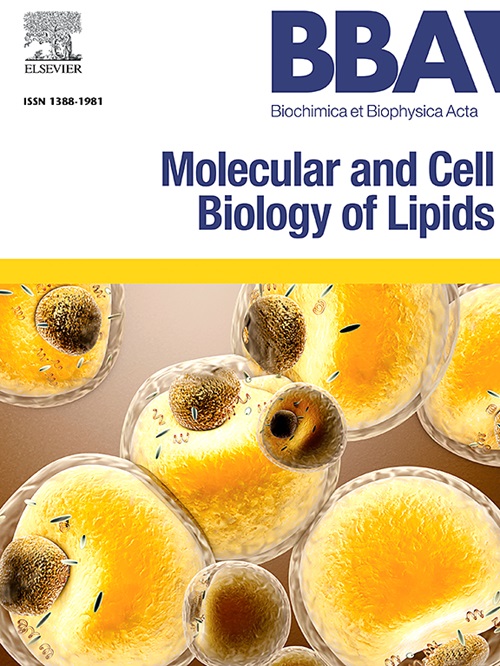Production, characterization and biodistribution of therapeutic high-density lipoprotein-like nanoparticles reconstituted with or without histidine-tagged recombinant ApoA1
IF 3.3
2区 生物学
Q2 BIOCHEMISTRY & MOLECULAR BIOLOGY
Biochimica et biophysica acta. Molecular and cell biology of lipids
Pub Date : 2025-02-20
DOI:10.1016/j.bbalip.2025.159606
引用次数: 0
Abstract
High-density lipoproteins (HDLs) are known for their cardiovascular protection due to apolipoprotein A-1 (ApoA1), their primary protein. ApoA1 promotes cholesterol reverse transport and exhibits antioxidant and anti-inflammatory properties. Although increasing HDL levels has not consistently reduced cardiovascular mortality in clinical trials, reconstituted HDL (rHDL) nanoparticles containing ApoA1 show potential in treating acute inflammation, such as in ischemic stroke, sepsis, and even COVID-19. ApoA1 is commonly produced in bacteria due to its simplicity and potential therapeutic optimisation. Addition of a histidine tag to recombinant ApoA1 may improve purification, stability and therapeutic efficacy, although its functional impact remains a subject of debate. In this study, ApoA1 with a poly-histidine tag (His-rApoA1) was produced in a clear coli system for simplified purification, followed by an evaluation of the tag's effects on rHDL nanoparticle properties. rHDL and His-rHDL nanoparticles were prepared using the sodium cholate dialysis method, combining recombinant rApoA1 or His-rApoA1 with phosphatidylcholine at a 1:75 M ratio. Nuclear magnetic resonance confirmed that both forms of rApoA1 structurally resembled plasma ApoA1, whether lipid-free or in nanoparticle form. Dynamic light scattering and electron microscopy revealed nanoparticle sizes around 7 nm with native HDL-like morphology. Testing on endothelial cells (EA.hy926) showed rapid uptake of rHDL and His-rHDL while preserving cell viability. Additionally, both nanoparticles reduced interleukin-6 and ICAM-1 expression in cells, demonstrating their anti-inflammatory and protective effects, unaffected by the poly-histidine tag. Intravenous injection in mice shows homogeneous distribution of His-rHDL in the liver, lungs, and spleen, with no cytotoxicity, indicating potential use for treating inflammatory diseases.
含或不含组氨酸标记的重组ApoA1重组的治疗性高密度脂蛋白样纳米颗粒的生产、表征和生物分布
高密度脂蛋白(hdl)因其主要蛋白载脂蛋白A-1 (ApoA1)而具有心血管保护作用。ApoA1促进胆固醇逆向运输,并具有抗氧化和抗炎特性。尽管在临床试验中,HDL水平的升高并不能始终降低心血管死亡率,但含有ApoA1的重组HDL (rHDL)纳米颗粒在治疗急性炎症(如缺血性卒中、败血症甚至COVID-19)方面显示出潜力。由于其简单性和潜在的治疗优化,ApoA1通常在细菌中产生。在重组ApoA1上添加组氨酸标签可能会提高纯化、稳定性和治疗效果,尽管其功能影响仍存在争议。在本研究中,我们在透明的大肠杆菌系统中制备了带有多组氨酸标签的ApoA1 (His-rApoA1),以简化纯化,随后评估了该标签对rHDL纳米颗粒特性的影响。采用胆酸钠透析法制备rHDL和His-rHDL纳米颗粒,重组rApoA1或His-rApoA1与磷脂酰胆碱按1:75 M比例组合。核磁共振证实两种形式的rApoA1在结构上类似于血浆ApoA1,无论是无脂的还是纳米颗粒形式的。动态光散射和电子显微镜显示纳米颗粒尺寸约为7 nm,具有天然高密度样形态。内皮细胞(EA.hy926)检测显示,在保持细胞活力的同时,rHDL和His-rHDL被快速摄取。此外,这两种纳米颗粒都能降低细胞中白细胞介素-6和ICAM-1的表达,表明它们具有抗炎和保护作用,不受多组氨酸标签的影响。小鼠静脉注射显示His-rHDL在肝脏、肺和脾脏均匀分布,无细胞毒性,表明其可能用于治疗炎症性疾病。
本文章由计算机程序翻译,如有差异,请以英文原文为准。
求助全文
约1分钟内获得全文
求助全文
来源期刊
CiteScore
11.00
自引率
2.10%
发文量
109
审稿时长
53 days
期刊介绍:
BBA Molecular and Cell Biology of Lipids publishes papers on original research dealing with novel aspects of molecular genetics related to the lipidome, the biosynthesis of lipids, the role of lipids in cells and whole organisms, the regulation of lipid metabolism and function, and lipidomics in all organisms. Manuscripts should significantly advance the understanding of the molecular mechanisms underlying biological processes in which lipids are involved. Papers detailing novel methodology must report significant biochemical, molecular, or functional insight in the area of lipids.

 求助内容:
求助内容: 应助结果提醒方式:
应助结果提醒方式:


